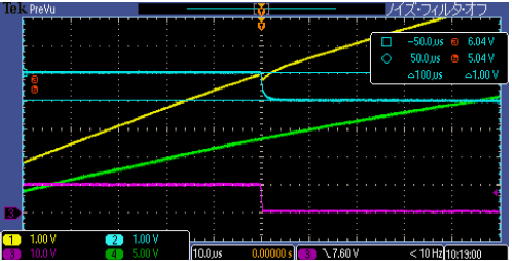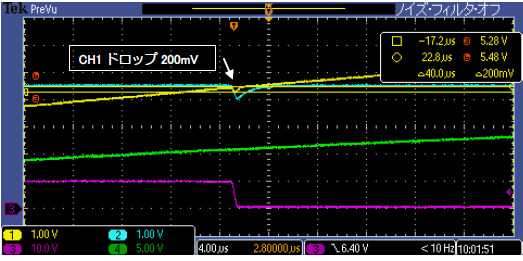Other Parts Discussed in Thread: , TLV1702
Dear Specialists,
My customer is evaluating LM293A and has a question.
I would be grateful if you could advise.
---
When the output terminal (pin 7) goes from HIGH to LOW, a drop also occurs at the input terminal 5pin and 6 pin.
I'd like to know this phenomenon is due to the characteristics of LM293A?
Could you please see listed below.
Figure 1. Schematic
(1)When the output terminal (pin 7) goes from HIGH to LOW, a drop also occurs at the input terminal 6 pin.
Figure 2.
Time 10.0us/div
CH1(yellow): IC5-6pin, 1V/div, CH2(blue): IC5-5pin, 1V/div, CH4(green):CL8(VBAT_24V), 5V/div, CH3(pink): IC5-7pin, 10V/div
(2) And then removed R157 to confirm IC5-5pin, became without hysterisis, IC5-5pin also drop(420mV) at the output transition.
Figure 3.
Time 4.0us/div
CH1(yellow): IC5-6pin, 1V/div, CH2(blue): IC5-5pin, 1V/div, CH4(green):CL8(VBAT_24V), 5V/div, CH3(pink): IC5-7pin, 10V/div
(3) When R59 is 200kohm to 20kohm and R62 is 100kohm to 10kohm, Voltage drop is reduced from 420mV to 200mV.
Figure 4.
Time 4.0us/div
CH1(yellow): IC5-6pin, 1V/div, CH2(blue): IC5-5pin, 1V/div, CH4(green):CL8(VBAT_24V), 5V/div, CH3(pink): IC5-7pin, 10V/div
(4) condition of (3) and R158 is 15kohm to 180kohm and add a 47kohm pulldown resistor at IC5-7pin, voltage drop is more better from 200mV(result of (3)) to 120mV.
Figure 5.
Time 4.0us/div
CH1(yellow): IC5-6pin, 1V/div, CH2(blue): IC5-5pin, 1V/div, CH4(green):CL8(VBAT_24V), 5V/div, CH3(pink): IC5-7pin, 10V/div
---
I appreciate your great help in advance.
Best regards,
Shinichi






